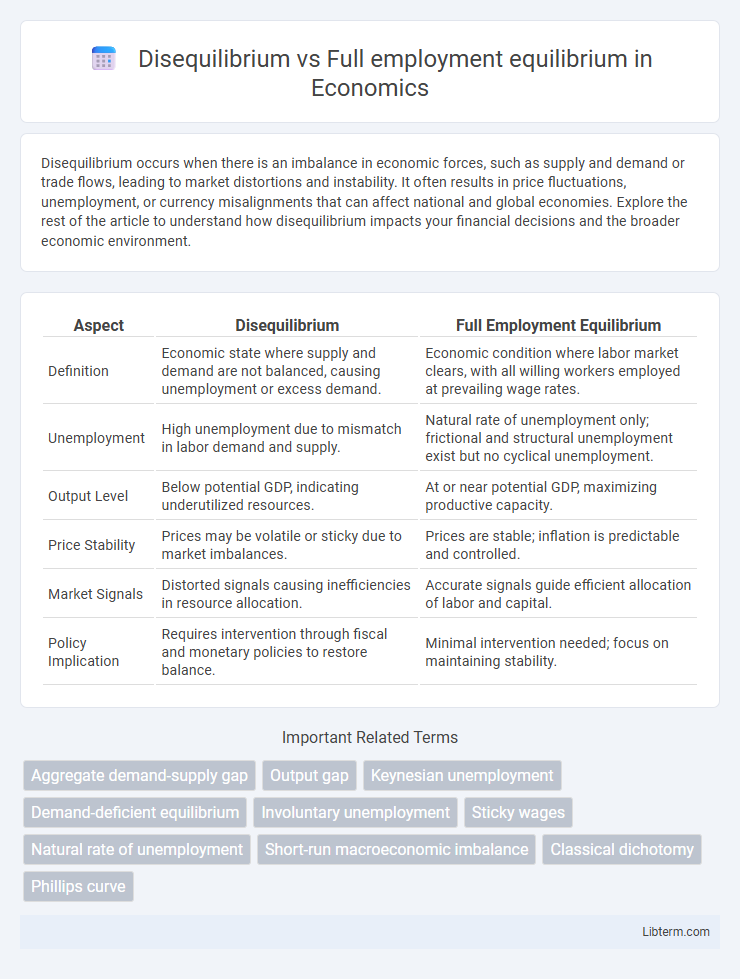Disequilibrium occurs when there is an imbalance in economic forces, such as supply and demand or trade flows, leading to market distortions and instability. It often results in price fluctuations, unemployment, or currency misalignments that can affect national and global economies. Explore the rest of the article to understand how disequilibrium impacts your financial decisions and the broader economic environment.
Table of Comparison
| Aspect | Disequilibrium | Full Employment Equilibrium |
|---|---|---|
| Definition | Economic state where supply and demand are not balanced, causing unemployment or excess demand. | Economic condition where labor market clears, with all willing workers employed at prevailing wage rates. |
| Unemployment | High unemployment due to mismatch in labor demand and supply. | Natural rate of unemployment only; frictional and structural unemployment exist but no cyclical unemployment. |
| Output Level | Below potential GDP, indicating underutilized resources. | At or near potential GDP, maximizing productive capacity. |
| Price Stability | Prices may be volatile or sticky due to market imbalances. | Prices are stable; inflation is predictable and controlled. |
| Market Signals | Distorted signals causing inefficiencies in resource allocation. | Accurate signals guide efficient allocation of labor and capital. |
| Policy Implication | Requires intervention through fiscal and monetary policies to restore balance. | Minimal intervention needed; focus on maintaining stability. |
Understanding Economic Equilibrium
Disequilibrium occurs when aggregate supply and aggregate demand are imbalanced, leading to unemployment or inflationary gaps, whereas full employment equilibrium exists where total output matches potential output with stable prices and no cyclical unemployment. Understanding economic equilibrium requires analyzing how market forces adjust wages, prices, and production levels to restore balance after shocks or policy changes. Key metrics such as GDP, unemployment rate, and inflation rate help identify whether the economy is in disequilibrium or at full employment equilibrium.
Defining Full Employment Equilibrium
Full employment equilibrium occurs when all available labor resources are utilized efficiently, and the economy operates at its natural rate of unemployment, typically around 4-5%, accounting for frictional and structural unemployment. Disequilibrium arises when aggregate demand and aggregate supply are out of balance, causing unemployment to exceed natural rates or inflationary pressures to build. Achieving full employment equilibrium ensures stable prices and maximum output without triggering excessive inflation or unemployment.
What is Disequilibrium in the Economy?
Disequilibrium in the economy occurs when aggregate supply and aggregate demand are not balanced, leading to unemployment or inflationary pressures. This imbalance prevents the economy from reaching full employment equilibrium, where all resources, including labor, are efficiently utilized. Market distortions, shocks, or policy inefficiencies often cause disequilibrium, disrupting optimal production and income distribution.
Key Differences Between Disequilibrium and Full Employment Equilibrium
Disequilibrium occurs when aggregate supply and aggregate demand are not balanced, leading to unemployment or inflation, whereas full employment equilibrium signifies a state where labor market clears with no cyclical unemployment. In disequilibrium, output is below potential GDP, causing underutilization of resources, while full employment equilibrium corresponds to optimal use of resources at natural unemployment levels. Price levels and wages may be rigid in disequilibrium, preventing automatic adjustment, unlike in full employment equilibrium where market forces facilitate stable price and wage adjustments.
Causes of Disequilibrium in Labor Markets
Disequilibrium in labor markets arises from rigidities such as wage stickiness, mismatches in skills between workers and job vacancies, and institutional factors like minimum wage laws or union activities that prevent wages from adjusting to clear the market. These distortions lead to persistent unemployment or labor shortages despite available job openings, contrasting with full employment equilibrium where labor supply equals labor demand and wages flexibly adjust. Structural shifts and information asymmetries further exacerbate disequilibrium by impeding efficient worker-employer matching.
Effects of Disequilibrium on Economic Growth
Disequilibrium in an economy, characterized by supply-demand mismatches or imbalances in labor and capital markets, hinders optimal resource allocation and slows economic growth. Persistent disequilibrium causes increased unemployment, underutilization of resources, and reduced consumer confidence, leading to lower investment and productivity. Full employment equilibrium establishes conditions for steady economic expansion by maximizing output and fostering a stable environment for capital accumulation and innovation.
Policy Responses to Disequilibrium
Policy responses to disequilibrium focus on correcting imbalances in the economy through fiscal stimulus, monetary adjustments, and supply-side reforms to restore full employment equilibrium. Central banks may lower interest rates to boost investment and consumption, while governments can increase public spending or cut taxes to stimulate demand and reduce unemployment. Structural policies targeting labor market flexibility and innovation also enhance long-term equilibrium by addressing mismatches between supply and demand.
Achieving and Maintaining Full Employment Equilibrium
Achieving full employment equilibrium requires balancing aggregate demand and aggregate supply so that all available labor resources are utilized without causing inflation. Disequilibrium occurs when unemployment exists due to insufficient aggregate demand or structural mismatches in the labor market, preventing output from reaching potential GDP. Maintaining full employment equilibrium involves continuous adjustments in fiscal and monetary policies to stabilize demand, promote efficient labor market functioning, and avoid deviations caused by external shocks or inflationary pressures.
Real-World Examples of Employment Equilibrium and Disequilibrium
Japan's prolonged period of low unemployment and stable inflation in the 1990s exemplifies full employment equilibrium, where labor market forces achieve balance. Conversely, the persistent high unemployment rates in Spain post-2008 financial crisis illustrate disequilibrium, caused by structural mismatches and rigid labor market regulations. These real-world cases highlight how economic policies and external shocks influence employment conditions and equilibrium states.
Implications for Future Economic Stability
Disequilibrium in the economy often leads to unstable market conditions characterized by unemployment, inflation, or output gaps, which hinder sustainable growth and create uncertainty for investors. In contrast, full employment equilibrium represents a state where resources are efficiently utilized, ensuring stable prices and consistent economic expansion conducive to long-term financial planning and policy effectiveness. Maintaining full employment equilibrium reduces the risks of economic shocks, promotes consumer confidence, and supports steady improvements in living standards, thereby enhancing overall future economic stability.
Disequilibrium Infographic

 libterm.com
libterm.com